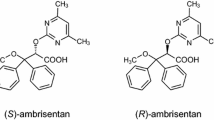Abstract
Capillary electrophoresis has been widely used as chiral separation technique, applying chiral selectors that are added to the background electrolyte. The advantages of capillary electrophoresis as separation technique are its flexibility, low cost, and high separation efficiency. This study is part of a research project, where guidelines are defined to facilitate interinstrumental method transfer of capillary electrophoretic methods, which is one of the major drawbacks of capillary electrophoresis. Another drawback is the lower sensitivity compared to liquid chromatographic methods. Improving and maintaining the sensitivity are the reason why focus should be put on the interinstrumental differences between detector settings. The aim of this study was to determine when adaption of the detector settings during interinstrumental method transfer was needed. The chiral separations of two betablockers were selected as case studies. The influence of detector parameters, such as data acquisition rate, bandwidth, and filter, on sensitivity responses, such as peak area, height, and width, was evaluated by means of robustness tests performed on two capillary electrophoresis instruments. The statistically significant parameters were identified and non-significance intervals determined. To maintain or optimise the obtained sensitivity, the information gathered from the robustness test was further incorporated in guidelines developed to facilitate interinstrumental analytical method transfer of capillary electrophoretic methods.





Similar content being viewed by others
References
Ahuja S (1991) In: Ahuja S (ed) Chiral separations by liquid chromatography. American Chemical Society, Washington DC, pp 1–8
Mangelings D, Vander Heyden Y (2011) Chiral separation methods for pharmaceutical and biotechnology products. In: Ahuja S (ed) lxChiral separation methods for pharmaceutical and biotechnological products, chapter 11. Wiley, New York, pp 331–350
Fillet M, Bechet I, Chiap P, Hubert Ph, Crommen J (1995) J Chromatogr A 717:203–209
http://www.fda.gov/Drugs/GuidanceComplianceRegulatoryInformation/Guidances/ucm122883.htm. Accessed 10 Aug 2017
Directive 75/318/EEC: investigation of chiral active substances, http://www.ema.europa.eu/docs/en_GB/document_library/Scientific_guideline/2009/09/WC500002816.pdf. Accessed 23 Aug 2017
International Conference on Harmonisation of Technical Requirements for Registration of Pharmaceuticals for Human Use, ICH Harmonised Tripartite guideline, specifications: test procedures and acceptance criteria for new drug substances and new drug products: chemical substances, Q6A. http://www.ich.org/fileadmin/Public_Web_Site/ICH_Products/Guidelines/Quality/Q6A/Step4/Q6Astep4.pdf. Accessed 10 Aug 2017
Gübitz G, Schmid MG (2004) Chiral recognition in separation science: an overview. In: Gübitz G, Schmid MG (eds) Methods in molecular biology; chiral separation methods and protocols, chapter 1. Humana Press, New Jersey, pp 1–29
Chankvetadze B (1997) Basics of capillary electrophoresis. In: Chankvetadze B (ed) Capillary electrophoresis in chiral analysis, chapter 1. Wiley, New York, pp 5–40
De Cock B, Dejaegher B, Stiens J, Mangelings D, Vander Heyden Y (2014) J Chromatogr A 1353:148–159
Hempel G (2000) Electrophoresis 21:691–698
De Kort BJ, De Jong GJ, Somsen GW (2013) Anal Chim Acta 766:13–33
Sluszny C, He Y, Yeung ES (2005) Electrophoresis 26:4197–4203
Chen Y, Lü W, Chen X, Teng M (2012) Cent Eur J Chem 10:611–638
Breadmore MC, Shallan AI, Rabanes HR, Gstoettenmayr D, Keyon ASA, Gaspar A, Dawod M, Quirino JP (2013) Electrophoresis 34:29–54
Stalmach A, Albalat A, Mullen W, Mischak H (2013) Electrophoresis 34:1452–1464
Pioch M, Bunz SC, Neusüss C (2012) Electrophoresis 33:1517–1530
Klepárnik K (2015) Electrophoresis 36:159–178
Sekhon BS (2011) J Pharm Educ Res 2:2–36
Gübitz G, Schmid MG (2014) Electrophoresis 23:3981–3996
Ingelse BA, Everaerts FM, Desiderio C, Fanali S (1995) J Chromatogr A 709:89–98
De Cock B, Dejaegher B, Stiens J, Mangelings D, Vander Heyden Y (2014) J Chromatogr A 1353:140–147
CE expert tool, Beckman Coulter, Fullerton, USA. https://www.beckmancoulter.com/wsrportal/wsr/research-and-discovery/products-and-services/capillary-electrophoresis/ce-expert-lite/index.htm. Accessed 10 Aug 2017
Vander Heyden Y, Nijhuis A, Smeyers-Verbeke J, Vandeginste BGM, Massart DL (2001) J Pharm Biomed Anal 24:723–753
Montgomery DC (2013) Three-level and mixed-level factorial and fractional factorial designs. In: Montgomery DC (ed) Design and analysis of experiments by Douglas montgomery a supplement for using JMP, chapter 9. SAS Institute Inc., Cary, North Carolina, USA, pp 173–188
Dejaegher B, Capron X, Smeyers-Verbeke J, Vander Heyden Y (2006) Anal Chim Acta 564:184–200
Mangelings D, Tanret I, Matthijs N, Maftouh M, Massart DL, Vander Heyden Y (2005) Electrophoresis 26:818–832
Dong F (1993) Stat Sin 3:209–217
Dejaegher B, Durand A, Vander Heyden Y (2008) J Chromatogr B 877:2252–2261
Perrin C, Fabre H, Massart DL, Vander Heyden Y (2003) Electrophoresis 24:2469–2480
P/ACE™ MDQ User’s Guide 32 Karat™ 8.0 (2009) Beckman Coulter, Fullerton, chapter 5, pp 41–47
https://www.agilent.com/cs/library/Support/Documents/a10424.pdf. Accessed 11 Jan 2017
Dejaegher B, Vander Heyden Y (2007) J Chromatogr A 1158:138–157
Vander Heyden Y, Jimidar M, Hund E, Niemeijer N, Peeters R, Smeyers-Verbeke J, Massart DL (1999) J Chromatogr A 845:145–154
De Cock B, Van Eeckhaut A, Stiens J, Mangelings D, Vander Heyden Y (2015) Electrophoresis 36(21–22):2658–2664
Author information
Authors and Affiliations
Corresponding author
Ethics declarations
Funding
No funding was granted for this study.
Conflict of interest
The authors declare that there are no conflicts of interest.
Human/animal rights statement
This article does not contain any studies with human participants or animals performed by any of the authors.
Electronic supplementary material
Below is the link to the electronic supplementary material.
Rights and permissions
About this article
Cite this article
De Cock, B., Mangelings, D. & Vander Heyden, Y. Interinstrumental Transfer of a Chiral Capillary Electrophoretic Method: The Use of Robustness Test Information to Overcome Differences in Detector and Data-Handling Specifications. Chromatographia 81, 335–348 (2018). https://doi.org/10.1007/s10337-017-3429-5
Received:
Revised:
Accepted:
Published:
Issue Date:
DOI: https://doi.org/10.1007/s10337-017-3429-5




